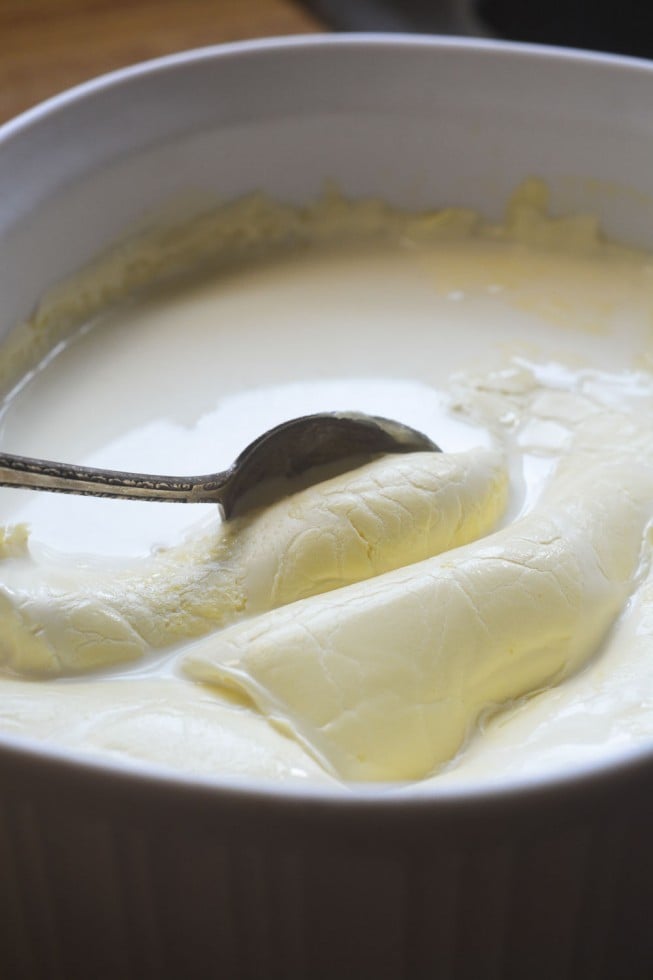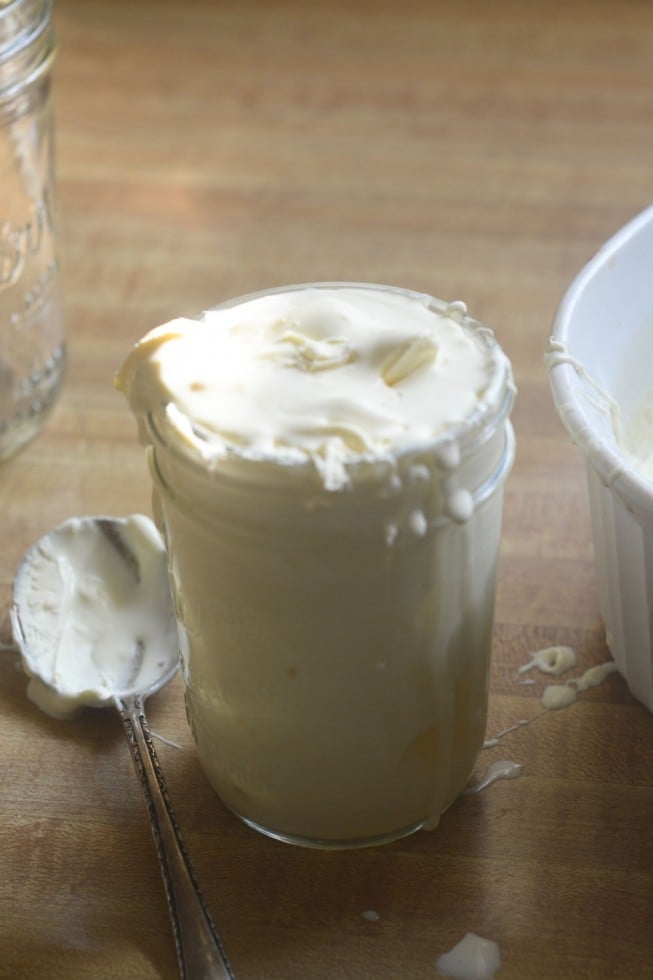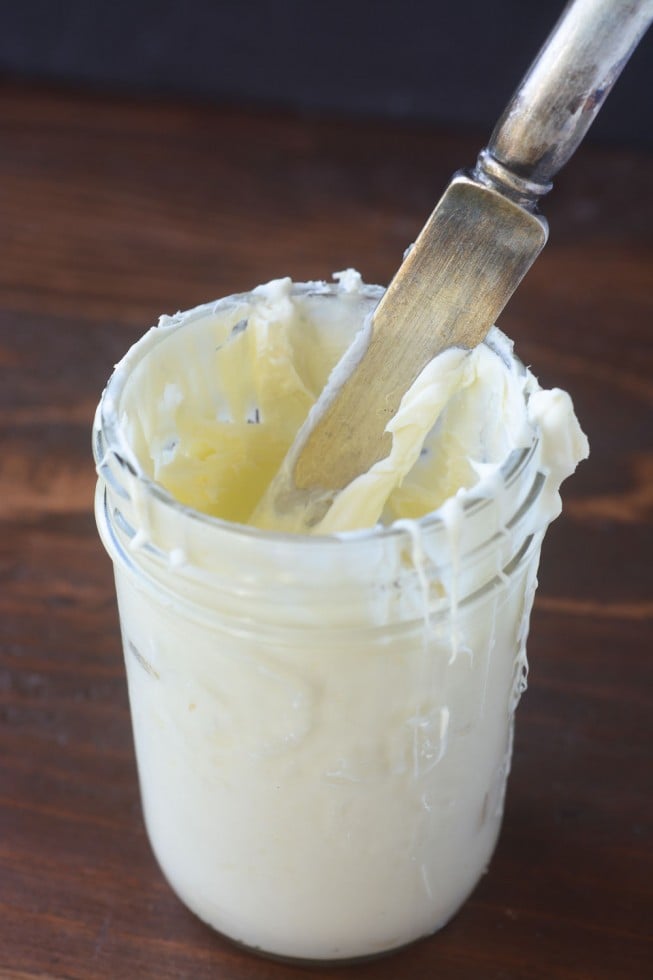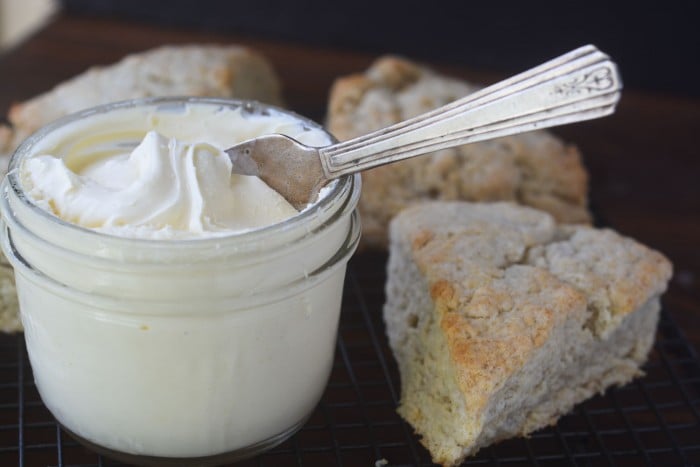“I have a British background and I have always had tea and something sweet. First time I tried this clotted cream I almost ate the entire jar by itself, it is that good!” ~Kim

If you’ve never had a classic English afternoon tea with scones and clotted cream, you’re missing out!
Last week I was treated by the historic Biltmore Hotel in downtown Los Angeles to their classic English afternoon tea. If you’ve never had a classic afternoon tea, you need to experience it. The highlight of any afternoon tea, besides the tea, is the array of tiny treats that comes with it, and I always zero right in on the scones and clotted cream. (That’s them on level two of our 3 tiered tea tray.)

What is Clotted cream?
If you’ve never had it, clotted cream is a very thick rich spreadable form of heavy cream that was first invented ages ago by some very smart British farmers. Traditionally cream heated until it thickens and develops a slightly nutty flavor. Clotted cream has a high fat content (around 55-65%) and a dense texture. It’s not like whipped cream, or cream cheese, it’s not like butter…it has a unique decadent consistency and a wonderful soft flavor. It’s quite thick and spreadable, and when you slather it on a freshly baked scone there is no better thing in the world.
The little pot of clotted cream that we got at the Biltmore had me craving more, and happily I made the most astounding discovery…you can actually make clotted cream at home in your own kitchen. No more tracking it down in specialty stores and paying big bucks for the imported stuff. My homemade clotted cream was actually way better (and a whole lot fresher) than the British stuff I usually buy.

What does clotted cream taste like?
Clotted cream has a rich, creamy taste with a slightly nutty ‘cooked’ flavor. It’s luxurious and indulgent, with a dense, velvety texture that is thicker and creamier than regular whipped cream. Clotted cream is also slightly sweet, but not as sweet as whipped cream or frosting, with a delicate flavor that pairs well with desserts, fruit, and scones. The crust on top of the clotted cream adds a slightly caramelized and nutty flavor, which many people find particularly delicious. The mouthfeel of clotted cream is a key part of its charm, and is like nothing else you’ve ever had!
what you’ll need
- heavy or whipping cream that has not been ultra-pasteurized
- This is cream that has been pasteurized, but not ultra-pasteurized. Ultra-pasteurized cream is cream that has been heated to a higher temperature than regular pasteurized cream to extend its shelf life.

How to make clotted cream
This is an amazing process, I hardly had to do anything, and I end up with a ton of the richest, silkiest clotted cream I’ve ever had.
- I used 2 pints of (non-ultra-pasteurized) heavy cream.
- I poured them into a baking dish, and left it overnight in a 180F oven (the lowest my oven will go.)
- In the morning I let it cool and then refrigerated it for the rest of the day.
- Then I scooped it into jars, which was a little sloppy at first, and put them back in the refrigerator. Any little bit of liquid gets absorbed right into the clotted cream after you put it in the jars, and by the next morning when I had it with my scones, it was absolutely to die for.

How long does clotted cream last?
Homemade clotted cream can last for up to 3-4 days when stored properly in the refrigerator. To extend its shelf life, it’s important to keep it in an airtight container and store it in the coldest part of the refrigerator, such as the back of the bottom shelf.
It’s important to note that clotted cream does not have any preservatives, so it should be consumed as soon as possible for the best flavor and texture. If you notice any changes in color, texture, or odor, discard the clotted cream immediately as it may have spoiled.

What to do with the leftover whey from making clotted cream
The leftover whey from making clotted cream can be used in a variety of ways:
- Adding it to smoothies or protein shakes for a boost of protein and nutrients.
- Using it as a substitute for milk or water in baking recipes such as bread, muffins, and pancakes.
- Using it as a marinade for meat or fish to tenderize and add flavor.
- Adding it to soups or stews for added richness and flavor.
- Using it as a liquid base for making homemade ricotta cheese or other soft cheeses.
- Feeding it to pets, as it is a good source of protein and nutrients for animals.
Note: It’s important to keep in mind that the leftover whey should be used or stored promptly to avoid spoilage. It can be stored in the refrigerator for up to a week or frozen for longer storage.

I can’t say enough good things about this project, the results far exceeded my expectations and it was absurdly easy. The only catch is that you can’t use ultra-pasteurized cream, which is cream that’s been processed for a longer shelf life. Many stores only sell ultra-pasteurized cream, so you have to search a bit for regular cream. I found mine at Whole Foods. Just read the labels… if it doesn’t say ultra-pasteurized on the label, you’re good to go.
can you make clotted cream with ultra-pasteurized cream?
Some readers in the comments below have had success with ultra-pasteurized cream. It is possible to make clotted cream from ultra-pasteurized cream, but it may be more difficult to achieve the desired texture and flavor. Ultra-pasteurization is a process that heats the cream to a higher temperature than regular pasteurization, which extends its shelf life but can also alter the proteins and enzymes in the cream. This can make it more difficult for the cream to form clots, which are necessary for making clotted cream.

What to eat with your homemade clotted cream
You will definitely want to make scones to go with your homemade clotted cream. I have lots of recipes for scones on the blog, but a simple one to start with is my Classic Cream Scones Recipe.

Tips for making clotted cream
- Make sure your cream is not ‘ultra pasteurized’, you will need to find regular pasteurized cream at a Whole Foods or other similar store. Ultra pasteurized cream has been treated in a way that prevents it from ‘clotting’.
- An oven thermometer is an essential kitchen tool, and really comes in handy for this project. If your oven is too cool or too hot your homemade clotted cream will not ‘clot’. Set your oven to 180F and then check the thermometer. You can adjust up or down as necessary.
- If your oven does not go down as low as 180F you can try one of my other methods for making clotted cream:

Homemade Clotted Cream
Video
Equipment
- a heavy casserole dish
Ingredients
- 2 pints heavy cream or whipping cream (double cream in the UK), avoid ultra-pasteurized cream for best results.
Instructions
- set your oven to 180F
- Pour the cream into the casserole dish. It should come up about 1-3 inches on the side.
- Set the dish, uncovered, in the oven and leave undisturbed for 12 hours. Be sure to leave the oven on the whole time. I do this overnight.
- Remove the dish from the oven and set to cool. Then cover and refrigerate. Note: the cream may seem thin at this point, but is going to thicken considerably overnight.
- The next morning scoop the thickened cream into a jar or jars, and cover and put back in the refrigerator. You can use the leftover cream for baking..
- Spread the clotted cream on freshly baked scones.
Nutrition























Did anyone succeed in using a crockpot?
One of the commenters did use a crockpot successfully, and I think I’m going to give it a try as well.
My family wouldn’t want me to run the oven all night long so I think a crockpot would be my best option if I want to try your recipe.
I’m doing a miniature, toaster oven trial run for this, and so far it seems to be working great! I’m planning on bringing this in for my English final dressed as Hamlet Sr. 🙂 So glad I’m able to make this from scratch!
Good luck 🙂
Sue please help ours didn’t work at all. We bought the right kind of cream and cooked it per instructions in a fairly deep oval baker the cream was around 2 inches deep. In the morning it was go,den brown almost like crime brûlée. We refrigerated all day then I tried to lift the skin off but the thicken cream was attached and under it was a good two inches of pur liquid. Tried to stir it in but it wouldn’t incorporate so we threw it out.
I’m sorry it didn’t work for you, Paula. From what you say it sounds like the oven temp was too high. Many times, even though the dial says one thing, the temperature can be different. If you have an oven thermometer, that might be the best thing to try.
Uhm, everything I have read and seen says your cream was clotted. The crunchy brown/yellow bits are a part of it.
I am giving it a go now. After 5 hrs it already is distinctively golden/yellow.
Please give it another go.
Thanks, Ava! I have been scouring the internet trying to figure out if I had done something wrong. The texture is perfect, though it looks a bit orange and has a slightly carmely taste. But still delicious!
Calibrate/check your oven temp. It is too high. I had the same thing happen with my first batch. Will start another batch for Thanksgiving this morning.
Thanks for the input Ava 🙂
I tried this and used exactly 2 pints of organic 35% fat cream, that was not ultrapasteurized in an oven for 12 hours at 170(after reading the comments about slight burning). It just turned out as a hardened yellow disc at the top of normal consistency cream, without anything resembling clotted cream in it at all.
Any idea what went wrong? I had to drop significant coin on this cream as most of what is commercially available in Canada has added skim milk powder and what I presume are stabilizers. Just don’t wanna mess this up again.
It’s possible that your oven was hotter than the 170F Jesse. I know I always have to count on an oven thermometer to check my temperature. Also check the size of your container, the pan shouldn’t be too large or the cream will be too shallow. There is a sort of hardened slightly colored skin on mine when I get it out of the oven, and then I stir it in and refrigerate, after which the clotted cream becomes thick and rich.
So excited to find this recipe! I have always wanted to try clotted cream but could never find any to buy except small shelf stable jars at World Market. Which are expensive and somehow seem like they would not be the “real” thing.
I will say if you don’t want to leave your oven on all night (mine is gas so I was leery). You can use a crockpot. Use one of the Hamilton beach ones with the little steam hole, or crack the lid a tad (the oven causes some evaporation while a crockpot will not with the lid on).
I did 1 quart of cream in a 3 quart crockpot for 12 hours, using the “keep warm” setting which is about 165F. looks just like the one in the photo with the light yellow crust on top. Waiting now for the crock to cool so I can stick it in the fridge 🙂
I can’t wait to try this, Jenny – thanks so much for letting me know – it sounds like an even better method!!
Let me know how it is after chilling…
Did anyone else get a browned skin on top after the overnight in the oven? I did. Maybe my oven was a little hotter? This morning I just peeled off the brown skin and after cooling, put the dish in the refrigerator. I hope it works!!
I did have a little skin on one of my batches, I just stirred it in…I think that means the oven was a little hot, Adrienne, or possibly your cream was to shallow?. Hope it works for you!
I ran to my local Whole Foods today with this recipe specifically in mind. I saw the cream and it all said pasteurized (not ultrapasteurized though). So I asked a salesperson if they carried UNpasteurized and was told it was illegal for them to sell it that way in our state. Help please! What do I do? Will pasteurized cream work? It looks so yummy and I really wanted it for tomorrow when my friend (who is British!) is coming over. Thanks so much!
Yes, it’s pasteurized you want. Just avoid “ultra-pasteurized”. Good luck, and remember to pay attention to detail when making this. I think the 2 pints works best, and make sure your oven is at the right temp and not too hot!
The other thing to remember is that after it comes out of the oven and cools, it still needs a good while in the fridge to completely firm up.
Thank you so much! Zipping back to Whole Foods right now…
Unpasteurized cream is “raw” cream, and you can usually get it from local dairy farms if you have any nearby.
If you are unable to find cream that is not ultrapastuerized, get some calcium chloride. Available from cheese making websites. You add about 1/4 tsp to this amount of cream before you put into the oven. This will help the curdling process. When making mascarpone I use the calcium chloride because I am unable to find non ultrapastureized cream. I buy my milk from the local dairy raw but they don’t sell the cream 🙁
Great to know, Linda!
If you buy raw milk, you can skim the cream from the top once it rises. I use a turkey baster to get it out of the jug. 🙂
Can I make half a recipe successfully? Looks soooo good!
Susan I think it’s much harder to do with half a recipe, but if you do try, make sure the cream has a certain depth to it in your container, and maybe cover it while it’s in the oven. I had one reader try with only one pint and it didn’t work as well.
Can I make half a recipe successfully? Looks soooo good!
Thanks for the response!
I’ve heard of clotted cream but never had it before. Don’t care for the name but it sure looks creamy and decadent.
Will have to try making it and see for myself. And high tea at the Biltmore looks like a must do!
The name is definitely strange, I agree…but you will be glad you tried it for yourself, Sophia!